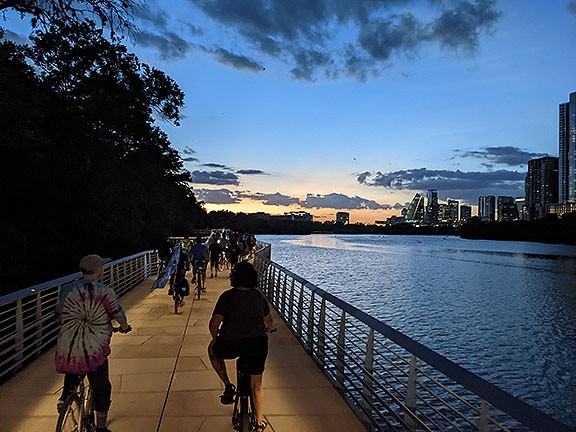
My first night in Austin after the 100 degrees cooled off a bit, we had a beautiful ride organized by Ride Bikes Austin… went along the Colorado River and saw the bats!
I’ve fallen in inconsequential ways a few times in my bicycling life. I was doored once but didn’t fall, and nearly doored a dozen times, always escaping by the skin of my (lucky) teeth. Somehow it was in Austin, Texas, on a blazing 103-degree Saturday afternoon, rolling along at 7 mph on a wide, flat dirt path along the river, looking everywhere but in front of me, that I found myself plunging into a small but real drainage ditch. The front wheel was mangled, and I flew into the handlebars and smashed into the ground. I got up scraped and seeing stars for a moment, the 4th finger on my left hand weirdly bent at the top knuckle, and felt a sharp pain in my chest. Broken rib? Cracked sternum?
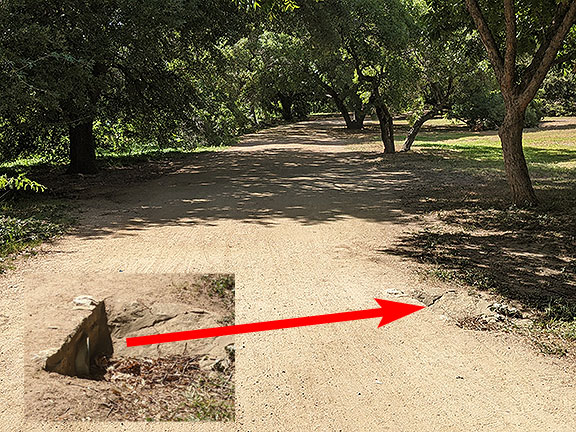
That invisible ditch, highlighted in box at left, is what got me… I can’t believe it!
Not wanting to risk a $35,000 ER bill from a Texas hospital I went back to my friends’ place and decided to fly home early the next morning. Adriana took me from the airport directly to the Kaiser ER, where xrays and EKG and a full exam concluded that I had nothing broken, no heart or lung problems, but a bad chest contusion, and “mallet finger.” Tomorrow I’ll get some more medical attention for my finger, which is really inhibiting my ability to type this, or to continue my steady pace of writing my new novel (which is why I’ve not been blogging for a while). So I had a real wreck! Dammit!
This past weekend I was invited to come to Austin by Raquel Ortega and Nona Allen of Ride Bikes Austin and the resuscitated Critical Mass there, who also gave me their couch and arranged a bicycle from the Austin Yellow Bike Project (thank you Pete and Dot!). It was a sweet experience, great to see Austin, albeit in an oddly fragmented (and very brief) way. I met a bunch of lovely folks on the two rides, Thursday and Friday evenings.
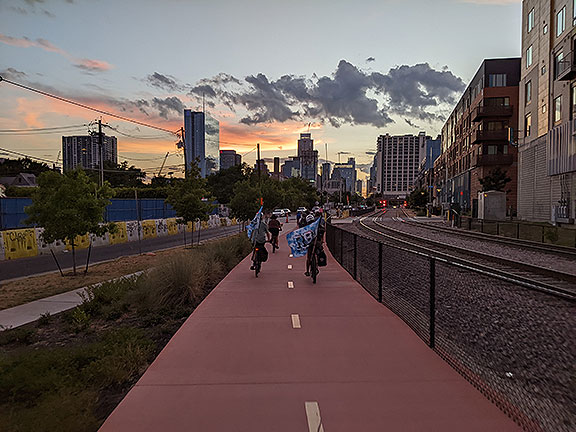
Lots of new bike paths that I got to sample a bit of during the two nights I got to ride… missed out on a third night due to my crash.
I have to say, I’m a bit surprised to have my peripatetic “Critical Mass diplomat” role suddenly come back to life. Maybe it’s because this is the 30th anniversary year, but there has been a notable uptick in attention and people reaching out to me, from Texas to Porto Alegre, Brazil, to major press outlets in Germany. Doesn’t alter the basic reality that here in San Francisco bicycling culture is almost kaput. Still lots of cyclists but no particular culture that foregrounds bicycling as a political or even important social choice. I’ve accepted that for years now.
But I’d say we did our part in shifting sensibilities, in permanently altering what passes for common sense. Whether or not most people choose to bicycle as their main mode of urban transportation is not so crucial—that probably won’t happen until there really are no easier alternatives—which may never come to pass. That’s ok. I know there are plenty of cyclist activists who are true believers—crusaders if you will—for their preference as the correct choice. I’ve never been there. I prefer to use a bicycle to get around. It’s easier and quicker and more pleasurable AND efficient FOR ME. And for many others. But not for everyone—of course!
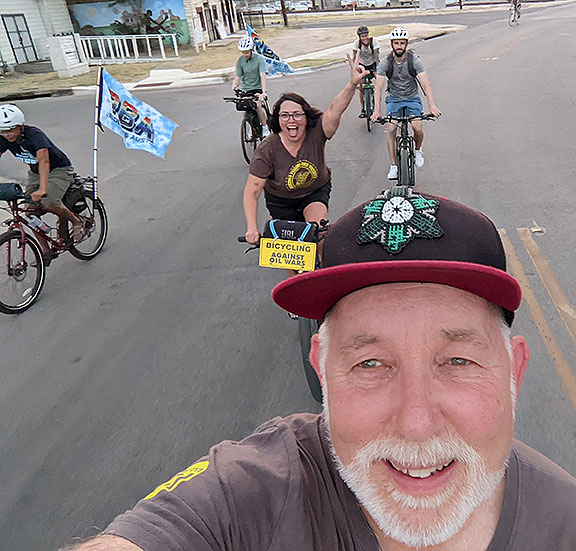
That’s Raquel Ortega behind me, and Nona Allen just to the left with the banner. Lovely hosts!
I would argue Critical Mass and Occupy and a variety of other social movements have importantly contributed to deeper contemporary change at a basic philosophical—even, perhaps epistemological—level. As evidence, I was struck while passing through the airport to see these books facing out from the bookshop there. I left the interesting ones in color to help identify them.
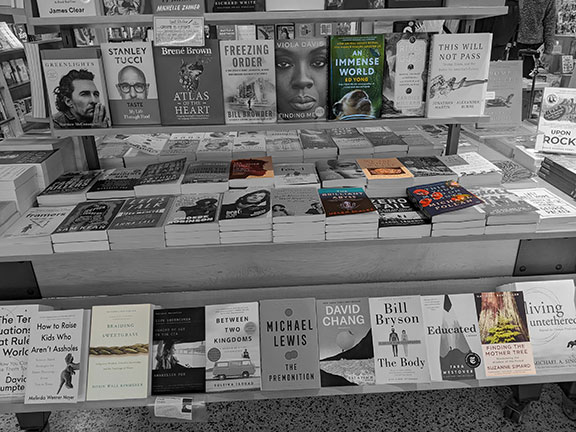
Books in color correspond to some of the ones cited below, but all are evidence of a shifting paradigm in our culture.
I finally read Braiding Sweetgrass a couple of months ago, and as all accounts have it, it’s a beautiful book—deep, soulful, inspiring, wise. Suzanne Simard’s book on the Mother Tree is there too, as is Michael Pollan’s latest on changing your mind with drugs. Further up are several books on the largely overlooked wonders of the deep oceans (which in a horrifying near future scenario, may be subject to a kind of ocean floor strip-mining!) and animal subjectivity and intelligence. Some of this new sensibility is rooted in a growing awareness of the fundamental intelligence of every aspect of the world around us, even things we’ve deemed inanimate. David Abram has written two excellent books that advance a scientifically aware and rationally based argument for animacy. A more broad return to indigenous sensibilities underlies a good deal of these new (old) ways of approaching life on earth. Here is a run of my favorite passages from a bunch of books I read in the past months, including some of the ones just mentioned.
I read a review of Elvia Wilk’s collection of essays Death by Landscape in High Country News, a magazine about the West that just keeps getting better. Her book lived up to its review, but especially the eponymous first essay, which examines the Area X trilogy by Jeff Vandermeer, which I’m just finishing—fantastic!
Faced with the possible annihilation of the planet as we know it, certain modes of knowing fall short. Especially insufficient is knowledge that purports humans to be distinct from ecosystems, much less in control of them. Among the “surprises and ironies at the heart of all knowledge production,” says Donna Haraway, is the fact that “we are not in charge of the world.” … In the writer Leslie Allison’s words: “Once the borders have dissolved, empathy is not just feeling others’ pain or pleasure. It is granting everything its own subjectivity. It is acknowledging that even non-human entities have a self with which to desire a particular way of living.” In Area X, the self dissolves—but self is also everywhere. Even the otter has a self now. (p. 90-91)
Wilk characterizes this new bio-science fiction as ‘weird,’ and I guess that’s ok. But the sensibility dovetails with this larger epistemological shift under way, which I’d say is not weird but necessary and perhaps mandatory! Robin Wall Kimmerer shares her participation as a professor of science as well as a member of the Potowatomi tribe in her now classic book, Braiding Sweetgrass: Indigenous Wisdom, Scientific Knowledge, and the Teachings of Plants:
… I hope I am also teaching them to know the world as a neighborhood of nonhuman residents, to know that, as ecotheologian Thomas Berry has written, “we must say of the universe that it is a communion of subjects, not a collection of objects.” (p. 56) … I envision a time when the intellectual monoculture of science will be replaced with a polyculture of complementary knowledges. (p. 139)
In the Indigenous view, humans are viewed as somewhat lesser beings in the democracy of species. We are referred to as the younger brothers of Creation, so like younger brothers we must learn from our elders. Plants were here first and have had a long time to figure things out. They live both above and below ground and hold the earth in place. Plants know how to make food from light and water. Not only do they feed themselves, but they make enough to sustain the lives of all the rest of us. Plants are providers for the rest of the community and exemplify the virtue of generosity, always offering food. What if Western scientists saw plants as their teachers rather than their subjects? What if they told stories with that lens? (p. 346)
Jessica Hernandez lives and teaches in Washington state, but her mother is a Zapotec Indian from Oaxaca in Mexico and her dad was a Salvadoran migrant, so she combines different threads of indigenous experience to inform her Ph.D. in ecological science for her book Fresh Banana Leaves: Healing Indigenous Landscapes Through Indigenous Science. As she clearly states, “Kincentric ecology describes how Indigenous peoples view their natural resources and surroundings as part of their kin, relatives, and communities. (p. 115)
Paul Chaat Smith, who is one of the main curators at the National Museum of the American Indian in Washington DC, has authored a kind of memoir, that is simultaneously on point and often hilarious. I highly recommend Everything You Know About Indians Is Wrong. It’s an important corrective to the double whammy of completely discounting and ignoring indigenous experiences and philosophies on one hand, or completely romanticizing a falsified memory of what “Indians” were or are, and missing the ways contemporary Indian lives partake of the same complexities and choices facing most of us.
Our political leaders might have been called kings or lords; instead, they were chiefs. Indian religious leaders could have just as accurately been called bishops or minister; instead, they were medicine men. Instead of soldier or fighter, warrior. And, perhaps, most significant, tribe instead of nation. (p. 17) … I find guilt trips incredibly boring and useless. So when I say, for example, that the Americas are built on the invasion and destruction of a populated land with hundreds of distinct, complex societies, and a centuries-long slave trade involving millions of Africans, I offer this as an observation that is the minimum requirement for making sense of the history of our countries. (p. 20) It isn’t about us talking and you listening, it’s about an engagement that moves our collective understanding forward. (p. 86)
David Abram has spent a lot of time trying to focus on the bodily experience on this planet. This has led him to remarkable clarity about the interconnectedness of everything that comprises this place, and how it shapes perceptions. He manages to cut through a lot of the bullshit that passes for ecological science, spiritual reverence, and fantastical stories that make up the theological universe for all too many people. His two books, The Spell of the Sensuous: Perception and Language in a More-Than-Human World and Becoming Animal: An Earthly Cosmology are great fun to read and leave you thinking in new ways about nearly everything!
Thus, at the most primordial level of sensuous, bodily experience, we find ourselves in an expressive, gesturing landscape, in a world that speaks. (Spell of the Sensuous, p. 81)
That so many indigenous people allude to the articulate speech of trees or of mountains suggests the ease with which, in an oral culture, one’s auditory attention may be joined with the visual focus in order to enter into a living relation with the expressive character of things. (Spell of the Sensuous, p. 130)… If human discourse is experienced by indigenous, oral peoples to be participant with the speech of birds, of wolves, and even of the wind, how could it ever have become severed from that vaster life? How could we ever have become so deaf to these other voices that nonhuman nature now seems to stand mute and dumb, devoid of any meaning besides that which we choose to give it? (Spell of the Sensuous, p. 91)
The human mind is not some otherworldly essence that comes to house itself inside our physiology. Rather, it is instilled and provoked by the sensorial field itself, induced by the tensions and participations between the human body and the animate earth. (Spell of the Sensuous, p. 262)
… to speak of enveloping nature in determinate, mechanical terms, or even to write of the environment in a purely functional manner, as “our human life-support system,” contravenes and cuts short the conviviality between our animal body and the animate earth. It stifles the spontaneous life of the senses. Our eyes begin to glaze over, our ears become deaf to the speech of tree frogs and the articulations of rain. What we say has such a profound effect upon what we see, and hear, and even taste of the world! (Becoming Animal, p. 64)
It is this primordial and ongoing participation that has gradually shaped the glistening eyes with which we now view the lights and shadows of this sphere, as it has shaped our listening ears, able to detect a wide range of sounds vital to human life while oblivious to many others. This ageless intercourse between the body and the earth—this coevolution—has shaped the organs and tissues of every earthly organism, deepening the color of our feathers and the powers of our claws, intensifying the bitterness of our leaves, outfitting our seeds with cotton sails so they’ll blow far on the summer winds. (Becoming Animal, p. 73)
The air is not a random bunch of gases simply drawn to earth by the earth’s gravity, but an elixir generated by the soils, the oceans, and the numberless organisms that inhabit this world, each creature exchanging certain ingredients for others as it inhales and exhales, drinking the sunlight with our leaves or filtering the water with our gills, all of us contributing to the composition of this phantasmagoric brew, circulating it steadily between us and nourishing ourselves on its magic, generating ourselves from its substance. It is as endemic to the earth as the sandstone beneath my boots. Perhaps we should add the letter I to our planet’s name, and call it “Eairth,” in order to remind ourselves that the “air” is entirely a part of the arth, and the I, the I or self, is wholly immersed in that fluid element. (Becoming Animal, p. 101)
Yet a new vision of our planet has been gathering, quietly, even as the old, armored ways of seeing stumble and joust for ascendancy, their metallic joints creaking and crumbling with rust. Beneath the clamor of ideologies and the clashing of civilizations, a fresh perception is slowly shaping itself—a clarified encounter between the human animal and its elemental habitat. (Becoming Animal, p. 299) … Commonly reckoned to be at odds with one another, conventional over-reductive science and most new-age spiritualities actually fortify one another in their detachment from the earth, one of them reducing sensible nature to an object with scant room for sentience and creativity, the other projecting all creativity into a supernatural dimension beyond all bodily ken. (Becoming Animal, p. 300)
Building on these kinds of sensibilities but in a much more prosaic and down-to-earth way, Peter S. Alagona has a brand new book about animals and wildlife in U.S. cities called The Accidental Ecosystem: People and Wildlife in American Cities. Sharing the rebuke of the anthropocentric view that assumes human capacities for knowledge and perception are obviously and inherently superior to all other life forms, he offers this useful passage:
Human perception is not objective reality; it is just what humans evolved to see, smell, touch, taste, and feel so that we might survive… If, as many virologists and immunologists believe, studying bats can help us better understand our own bodies, leading to treatments that benefit human health and perhaps even help prevent the next pandemic, then science may allow bats and people to become just a little more alike. Humans may—at long last and to our great benefit—get a bit more of a sense of the bizarre, alien, magical experience of what it must be like to be a bat. (p. 150)
Jennifer Ackerman has written several insightful books about birds. I read The Bird Way: A New Look at How Birds Talk, Walk, Play, Parent, and Think and learned a ton! There are more than a dozen books on the shelf at the Main Library in San Francisco that delve into the rapidly expanding body of scientific inquiry into the minds of animals. Ackerman’s was excellent, and as you’ll see from these passages, her reporting and the work of the scientists she’s covering are very much a part of this shifting sense of what we know. Perhaps it’s part of a new humility, facing the reality that we’ve missed out on so much going on all around us all this time!
In fact, big parrots like macaws and cockatoos, as well as corvids such as ravens and crows, have higher neuron counts in the forebrain than do monkeys with much larger brains—in some cases, twice as many neurons, with more connections between them—which explains why these birds are capable of cognitive feats comparable to those of the great apes. (p. 17)
Mary Caswell Stoddard, an assistant professor of ecology and evolutionary biology at Princeton University, who studies avian color vision. “It’s that ultraviolet light is a fundamental part of many of the colors they perceive. They’re experiencing another whole dimension of color—all the colors we can see, with varied amounts of UV mixed in. So it’s not simply human vision plus some purplish UV colors. It’s a complete reimagining of the color experience.” (p. 95)
As the great essayist Lewis Thomas wrote, smell is a mode of knowing, remarkably like the act of thinking itself. The way birds use their senses offers clues to another kind of knowing. [emphasis added] (p. 321)
Birds have also shown us that we’re not unique in the ways we once thought. The teasing and clowning play in kea tells us that neither the capacity to be aware of other minds nor the wish to play with them belongs to humans alone. Nor are we alone in using aspects of language or tools, or in building complex structures, or in understanding, manipulating, and deceiving other animals. We may, however, be alone in devising reasons why we’re special. (p. 323)
Finally, Carl Safina is another writer looking at animal intelligence in its myriad capacities, many of which are parallel to or even superior to human capacities. I read his Becoming Wild: How Animal Cultures Raise Families, Create Beauty, and Achieve Peace and while I think the title is a bit grandiose, the content of the book was endlessly fascinating.
Parrots are capable of recalling past events, thinking ahead, taking the visual perspective of others, and sometimes creating novel tools to solve problems. These are cognitive feats, “thought until not long ago to be uniquely human,” says one group of researchers based at the University of Cambridge. The parrots haven’t changed. It’s as if we are just waking up from a long journey through space and having a look around an interesting new planet. (p. 129) … the world appears beautiful so that the living may love being alive in it. Life has developed—and we have inherited—a sense of the beautiful to let us feel at home in the world, without further reason. (p. 203)
That last point about beauty is an interesting assertion, fitting together rather nicely with some of David Abram’s ruminations on how we’re all actually part of the great mind of the planet, all partaking of and contributing to the endlessly circulating atmosphere, the water cycle, and life in all its forms. Beauty is something we all produce, and we all appreciate and are drawn to. Perhaps it’s not so mysterious after all. We are all in it together, no matter how much we might feel cut off and alone in our personal psychological hells. There is only one life, and we are components of that life, not stand-alone beings, whatever tricks our ego plays on us. And I urgently hope that the proposed shift in sensibilities that led me to post this series of quotes will in time lead to radically different ways of producing life together, doing away once and for all with wage-labor, capitalism, billionaires, oil companies, banks, landlords, and all the many other obsolete roles the dying world has imposed. The new world is trying to birth itself, in no small part by reconnecting to ways of knowing that evolved on this continent for thousands of years before being violently disrupted by several centuries of settler colonialism. All these works are contributions to this unfolding process.












Sorry to hear about your fall… and of course the whole medical insurance industry is such a clusterfuck… nothing good to be said about. I can’t believe anyone buys the absurd assertion that this is the best medicine available in the world! Sheesh! … and yeah, the nazis… how long till their hold on things disintegrates? and what will catalyze such an eventuality?…
Great first person reporting, as always. Sorry about your fall, which corresponds to one I took in a garden, resulting in completely torn rotator cuff tendons and imminent surgery. My neighbor has the same fall and surgery a couple of months ago, but whereas my bill should be around 95 dollars because of a state employee’s better health insurance, his small state teacher’s insurance has him paying a 7000 dollar “deductible” as a start, plus who knows what else. What a mafia scam, idiotic and harmful in the extreme, to have such disparate financial suffering from the same condition, but only good old Bernie seems to want to finger-wag about this. You were right to get the hell out of Texas.
Sorry, too- no supposed “paradigm” shift is stopping the supersystem. The nazis are in charge, of earth or Eaarth or Eairth or whatever is left from the collapse’s damage.
Wow! I finally had a chance to read this blog post in full. Thank you for sharing your perspective on your recent trip to Austin and for the overview of books with subject matter that almost feels curated specifically for me! Perhaps that sensation is only because the subjects are relevant to any person!
I’m just jumping in here to say that I’m glad you’re feeling better, Chris!